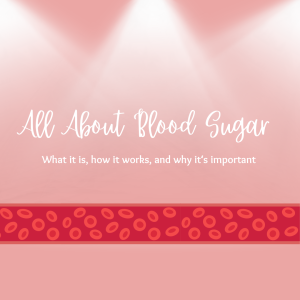Blood Sugar: How it Works and Why it’s Important
By Vivienne Couris, C2ST Intern, DePaul University

The first molecules we’ll meet are the glucose molecules. These little guys are obtained from the food you eat, which then gets pumped into the bloodstream during digestion. They are your body’s preferred energy source, and make up the “sugar” part of the term “blood sugar”. Once the glucose molecules make it to the bloodstream, they’ll float around freely and wait for their best friends- the insulins.
Insulin is a type of hormone secreted by an organ known as the pancreas, which sits just behind your stomach. The pancreas knows to release insulin as soon as you start eating, since lots of glucose will be entering the blood at this time. Glucose molecules will wait patiently for these insulins to be pumped into the bloodstream with them, as they are a key helper in glucose’s goal of energizing the cells.
Insulins are eager to help the glucose molecules fulfill this objective. Once they have made it to the bloodstream, they will begin rushing around to different cells (the tiny building blocks of the body) and allowing glucose molecules to pass through the plasma membrane (the gateway to the inside of the cell). Glucose can only enter a cell through its glucose channel– a specialized point of entry that can open or close via receptors. Insulins act like a key, and receptors like a keyhole. An insulin molecule will insert itself into the glucose receptor in order to “unlock” the glucose channel. Once the channel has been unlocked, the glucose molecules can freely enter the cell and provide it with the energy it needs.
Ideally, glucose and insulin would remain best friends in every body. Unfortunately, however, this doesn’t always happen. For various reasons, blood sugar can rise too high or fall too low, and insulin production or reception can fail. The most notable example of this is a condition called type II diabetes, which is a disease that occurs when there are too many glucose molecules in the bloodstream and not enough insulins to help them enter cells. If type II diabetes is left unmanaged, it will cause blood sugar levels to remain dangerously high and produce a range of scary symptoms like blindness and kidney damage. Luckily, type II diabetes can be easily prevented through lifestyle changes and healthy habits. Additionally, there are several treatments available to those who already have the disease.
In addition to blood sugar levels rising too high, problems can also arise when blood sugar falls too low. This is typically caused by skipping meals or by certain drugs or diseases that inhibit normal glucose release. This condition, known as hypoglycemia, can cause symptoms like blurred vision, confusion, and fainting. Luckily, this condition is usually temporary and can be cured quickly by consuming high-sugar foods or drinks as soon as symptoms begin to appear.
Overall, problems with blood sugar, especially high blood sugar, are increasingly common in today’s society. Type II diabetes affects 30 million people in the US alone, and is a leading cause of death. Eating nutritious meals at least three times per day, maintaining a healthy body fat level, consuming adequate protein and healthy fats, and engaging in frequent exercise are key ways to reduce blood sugar-related diseases, and keep our new friends glucose and insulin happy.
References
- https://www.youtube.com/watch?v=HJGjNTJgf48
- https://www.healthline.com/health/glucose#how-glucose-works
- https://www.ncbi.nlm.nih.gov/pmc/articles/PMC8232639/#:~:text=The%20major%20purpose%20of%20insulin,%2C%20muscle%2C%20and%20adipose%20tissue.
- https://en.sinocare.com/blogs/diabetes/how-does-glucose-enter-the-cell#:~:text=Sodium%2Dindependent%20transporters.,to%20cross%20the%20lipid%20barrier.